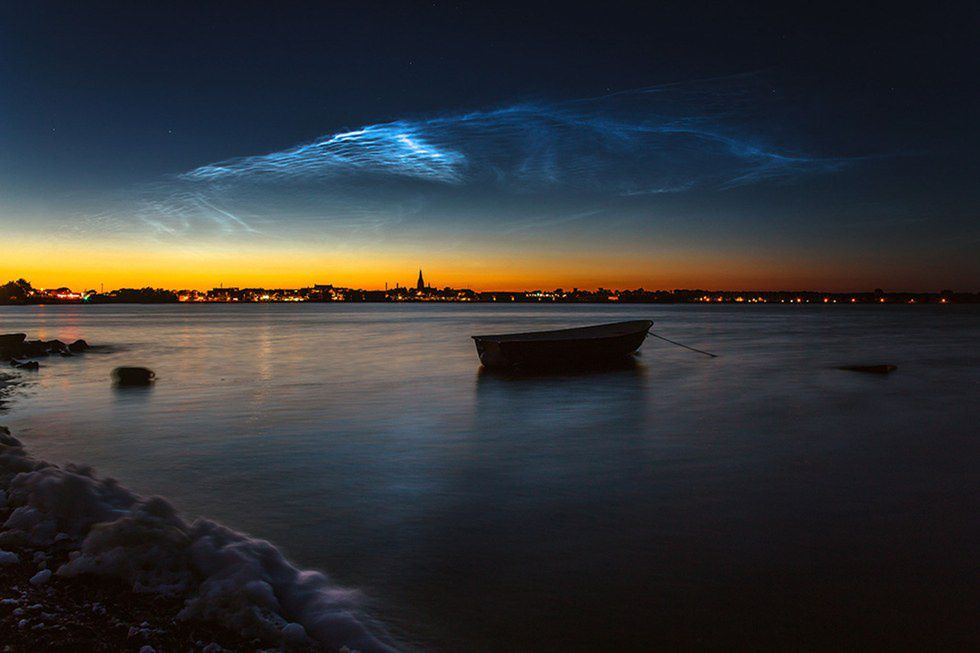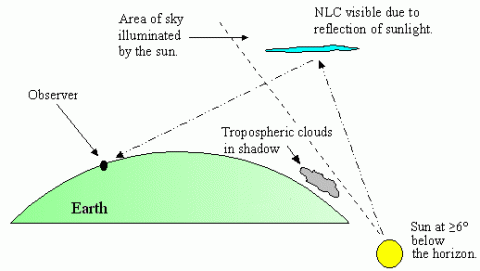The year is 1849, Thomas Romney Robinson makes a series of unusual observations in Armagh, Northern Ireland. He described a series of strangely luminous clouds, all appearing at night, that were oddly like auroras but certainly were not the famed northern lights. In the Scientific Notices of Arago, published in 1982, it is written that Mr. Robinson made various “observations on the phosphorescent properties of ordinary clouds. It is greatly to be desired that this learned astronomer communicates these without delay to the public.” Gadsden’s Notices were published after Mr. Robinson died, almost blind, in the February of 1882. Despite being observed in 1849 and officially discovered in 1885– after the 1883 eruption of Krakatoa– noctilucent clouds are considered a rather recent scientific discovery.
At the time of their official discovery, scientists assumed that the noctilucent clouds were simply an unusual manifestation of the volcanic ash that had flooded the atmosphere only two years prior. In 1926, however, meteorologist Malzev disproved that theory. Even the description used by Malzev was unusual, calling the clouds “luminous.” That specific description only appeared between 1849 and 1852, a rather short period of time; and within that period of time, there are only ten known references, most of which are in the colder months of the year. These winter observations could have been the also rare nacreous clouds– otherwise known as polar stratospheric clouds– which have an equally luminous appearance, but mainly appear in the winter months. However, despite the visual similarities PSCs are generally lower in the atmosphere than noctilucent clouds, which reside on the outer edge of the mesosphere.
The two images above show noctilucent clouds and nacreous clouds, respectively.
The occurrence of these noctilucent clouds picked up again in 1962 after the first rocket was launched, leading scientists to believe that their appearance was dependent upon the presence of particles high up in the atmosphere where they would not normally be. The presence of particles high up in the atmosphere is not the only determining factor in the appearance of these electric blue clouds, however. Their range of visibility is also limited to latitudes greater than fifty degrees north or south of the equator as well as being more common in the warmer months of the year for each hemisphere respectively. This is due in large part to the fact that the clouds are formed mainly by tiny ice and dust particles at the edge of the mesosphere, but the clouds glow due to the fact that said ice and dust particles reflect and refract setting sunlight when it hits the clouds at just the right angle. It takes the cold atmosphere to freeze the ice particles, it takes rockets or volcanoes to release just enough material to freeze, and it takes an extremely northern or southern latitude for the sun to hit at the correct angle; hence why noctilucent clouds are rarely seen in the United States of America.
Some scientists believe that noctilucent clouds are indicators of a larger meteorological issue, such as the ozone layer decaying or climate change. In 2007 NASA launched the Aeronomy of Ice in the Mesosphere program, or AIM, to conduct further observations and research on these mysterious clouds. As of 2014, the program had only observed the clouds near the poles, which is where the ozone hole is located, but despite the seemingly small area the actual occurrence of these clouds increased by 40-50%. This ever growing number suggests a large-scale climate change that is causing the ever increasing number of mesospheric clouds. Could these clouds actually denote a large scale issue that humanity has inadvertently caused, or are they simply an atmospheric phenomenon like any other?
Science Daily explains NASA’s research, stating that, “To study long-term changes in noctilucent clouds, Russell [the lead researcher] and his colleagues used historical temperature and water vapor records and a validated model to translate this data into information on the presence of the clouds.” Making use of temperature data from 2002 to 2011, NASA’s researchers created a model that they then compared to their observations, proving that it lined up well enough to be a trustworthy model that can be used to perhaps predict the future: “The model showed that the occurrence of noctilucent clouds had indeed increased from 2002 to 2011. These changes correlate to a decrease in temperature at the peak height where noctilucent clouds exist in the atmosphere,” they explain, “Temperatures at this height do not match temperatures at lower levels – indeed, the coldest place in the atmosphere is at this height during summertime over the poles – but a change there certainly does raise questions about change in the overall climate system.” Russel and the rest of the team NASA assembled for this study continue to watch the clouds and data to see if they can determine if “the noctilucent cloud frequency increase and accompanying temperature decrease over the 10 years could be due to a reduction in the sun's energy and heat.”
The New York Times discusses the same researchers, asking these questions: “Where is the dust seeding the clouds coming from? Is it composed of tiny meteors from outer space, particles wafting up from the lower atmosphere, or possibly charged atoms created in that part in the atmosphere?” Among other questions, such as why the southern hemisphere’s noctilucent clouds are almost a mile higher in the atmosphere that the clouds in the northern hemisphere. But whether or not the clouds are linked to pollution or climate change, there is no doubt that due to their unusual location in the atmosphere noctilucent clouds allows scientists to study interactions between the layers of the atmosphere and how the hemispheres affect each other. So, if you should decide to travel to Ireland, Russia, or Greenland in the summer, make sure to bring your camera, because we can never have too many pictures of these rare and beautiful, luminous clouds.
























